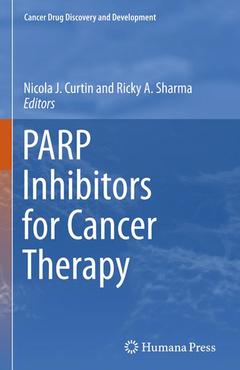Description
PARP Inhibitors for Cancer Therapy, Softcover reprint of the original 1st ed. 2015
Cancer Drug Discovery and Development Series
Coordinators: Curtin Nicola J., Sharma Ricky A.
Language: English
Subjects for PARP Inhibitors for Cancer Therapy:
Publication date: 02-2018
Support: Print on demand
Publication date: 06-2015
591 p. · 15.5x23.5 cm · Hardback
Description
/li>Contents
/li>Biography
/li>Comment
/li>
PARP Inhibitors for Cancer Therapy provides a comprehensive overview of the role of PARP in cancer therapy. The volume covers the history of the discovery of PARP (poly ADP ribose polymerase) and its role in DNA repair. In addition, a description of discovery of the PARP family, and other DNA maintenance-associated PARPs will also be discussed. The volume also features a section on accessible chemistry behind the development of inhibitors.
PARP inhibitors are a group of pharmacological inhibitors that are a particularly good target for cancer therapy. PARP plays a pivotal role in DNA repair and may contribute to the therapeutic resistance to DNA damaging agents used to treat cancer. Researchers have learned a tremendous amount about the biology of PARP and how tumour-specific defects in DNA repair can be exploited by PARPi. The ?synthetic lethality? of PARPi is an exciting concept for cancer therapy and has led to a heightened activity in this area.
History of the discovery of poly (ADP-ribose).- Discovery of the PARP superfamily and focus on the lesser exhibited but not lesser talented members.- The role of PARPs in DNA Strand Break Repair.- TIPs: Tankyrase Interacting Proteins.- PARP and Carcinogenesis.- Multitasking roles for poly(ADP-ribosyl)ation in aging and longevity.- Overview of PARP Inhibitor Design and Optimization.- Structure Based Design of PARP Inhibitors.- Preclinical chemosensitization by PARP inhibitors.- Classification of PARP inhibitors based on PARP trapping and catalytic inhibition, and rationale for combinations with topoisomerase I inhibitors and alkylating agents.- Radiosensitisation by poly(ADP-ribose) polymerase inhibition.- The vasoactivity of PARP inhibitors.- Synthetic lethality with Homologous Recombination Repair defects.- Targeting tumour hypoxia with PARP Inhibitors: Contextual synthetic lethality.- Other determinants of sensitivity.- Synthetic sickness with molecularly targeted agents against the EGFR pathway.- Disruption of DNA repair by cell cycle and transcriptional CDK inhibition.- Resistance to PARP Inhibitors Mediated by Secondary BRCA1/2 Mutations.- PARP inhibitor resistance - what is beyond BRCA1 or BRCA2 restoration.- Introduction to PARPi clinical trials and future directions.- Clinical trials investigating PARP inhibitors as single agents.- Clinical trials of PARP inhibitors with chemotherapy.- Combination of PARP inhibitors with clinical radiotherapy.- Biomarkers for PARP Inhibitors.
Nicola Jane Curtin, Ph.D. is Professor of Experimental Cancer Therapeutics at Newcastle University. Dr. Curtin is also the team leader for DNA damage signalling and repair projects within CR-UK Drug Development Programme.
Ricky Sharma is Associate Professor at the University of Oxford and Honorary Consultant in Clinical Oncology at the Oxford University Hospitals NHS Trust. He graduated in medicine from the University of Cambridge, and subsequently trained in toxicology, general internal medicine, medical oncology and clinical oncology in Cambridge, Glasgow, Leicester and London. Since 2006, he has led a translational research group at the University of Oxford focussed on DNA damage repair and the development of new chemotherapy and radiotherapy treatments for cancer.




